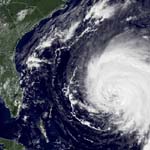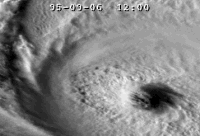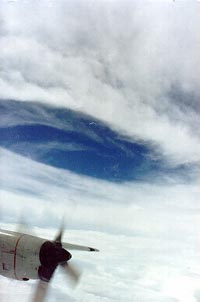| (insert your NIE or newspaper logo here) |
Weekly Online LessonOnline Lesson ArchiveGrade Level: 5-10
|
An Eye On Hurricanes
 Hurricane Isabel thrashed the northeastern U.S. last week. Across seven states, from North Carolina to Pennsylvania, the hurricane's force cut power, drowned cars, ripped off roofs, uprooted trees, and resulted in at least 30 deaths.
Hurricane Isabel thrashed the northeastern U.S. last week. Across seven states, from North Carolina to Pennsylvania, the hurricane's force cut power, drowned cars, ripped off roofs, uprooted trees, and resulted in at least 30 deaths.
Despite the damage, though, things could have turned out a lot worse. After all, Isabel, at her peak just off the coast, was classified as a Category 5 hurricane. When she finally hit land, her force had diminished to Category 2 conditions.
Furthermore, knowing about and tracking the hurricane in advance helped people plan for the inevitable. Meetings were rescheduled, windows were taped up, bottled water was stocked up, and some people even left their homes for safer shelter.
For this week's lesson, you'll explore the basics of hurricanes and hurricane history. You'll also get to join a crew of Hurricane Hunters on their mission to track these mighty forces.
The Nature of Hurricanes
 One of the best places to check out hurricanes is FEMA for Kids. In their Disaster Area, go to the Hurricanes section. What causes a hurricane to form? In which direction do hurricanes rotate?
One of the best places to check out hurricanes is FEMA for Kids. In their Disaster Area, go to the Hurricanes section. What causes a hurricane to form? In which direction do hurricanes rotate?
Use the left-hand index to navigate through this site, starting with The 15 Biggest Hurricanes from 1900-2000 and The History of Hurricanes.
Also read the answer to the question, Why Can't We Stop Hurricanes?
What region of the country seems to get hammered by hurricanes? In what culture did the name "hurricane" originate? How is life on the hurricane-prone coastline different today than before technologically advanced weather forecasting? Why did scientists and the government give up on trying to stop hurricanes?
Move on to Hurricane Classification, which explains what a hurricane Category 2, for example, means. Think about how each class of hurricanes would feel like if you were moving that fast in a car!
 Go ahead and read about past hurricanes, like Hurricane Andrew that whipped through the southeast in 1992 and became the most destructive hurricane on record. To learn more about some of these significant hurricanes, take a side trip to NOAA's Hurricane History. Here, you can view maps of each hurricane's path. What were some of the effects of each hurricane?
Go ahead and read about past hurricanes, like Hurricane Andrew that whipped through the southeast in 1992 and became the most destructive hurricane on record. To learn more about some of these significant hurricanes, take a side trip to NOAA's Hurricane History. Here, you can view maps of each hurricane's path. What were some of the effects of each hurricane?
Back at the FEMA site, look at the Starting Points for Hurricanes. How do these points correlate with the pathways you noticed on the maps of the biggest hurricanes?
Make sure to also browse the Disaster Intensity Scales. How does the damage caused by the five categories of hurricanes compare to that caused by the different intensities of tornadoes, earthquakes, and volcanoes?
Learn more about the hazards of hurricanes at NOAA's website, National Hurricane Awareness Week. Here, you can read about storm surges, high winds, and inland flooding. How exactly does a hurricane cause these other forces? In what ways can people in hurricane-prone areas guard against damage from these forces?
Hurricane Hunters
 At the FEMA site, read a bit about the Hurricane Hunters, then take off to their home site, HurricaneHunters.com.
At the FEMA site, read a bit about the Hurricane Hunters, then take off to their home site, HurricaneHunters.com.
Start your tour with their recent eye to eye view of Hurricane Isabel. You can also browse their gallery of Eye to Eye views with other hurricanes, including those occurring this season.
What kinds of measurements do the hunters take, and why do you think they're important? Why do the hunters take several flights into each hurricane?
The History of hurricane hunting is really interesting, too, so don't miss reading about the first flight that was done on a dare!
Find out more about what Hurricane Hunters do by browsing their FAQs and tagging along on the Cyberflight. What is a dropsonde? What are the different jobs of each crew member? What happens when the plane penetrates the eyewall? How is the temperature different in the eye? Where does the weather data the plane collects get sent?
If you'd like to track hurricanes this season from your computer chair rather than from a Hurricane Hunter's seat, you can find some good tools online. First jump back to the FEMA site and learn How To Track A Hurricane. You can download the map then check the National Hurricane Center daily for data on active hurricanes.
Newspaper Activities
In current issues of Targetnewspaper look for stories about Hurricane Isabel or other hurricane activity. How long was the hurricane active? Which areas of the country did it affect? Did residents experience any storm surges or flooding? What kinds of damage did it do to buildings and homes, and about how much might it cost to repair and cleanup afterward? Has power been fully restored? How do you think forecasting the weather conditions in advance possibly minimized the property damage and death toll compared to the potential results without such predictions?
© Copyright 2003
Learners Online, Inc.
